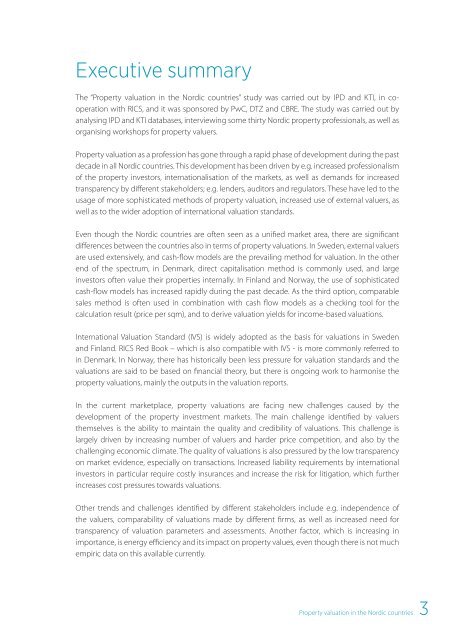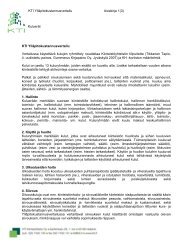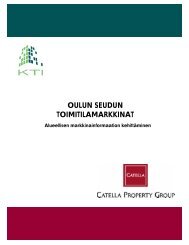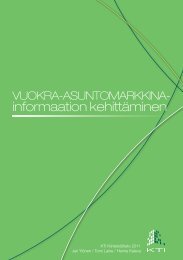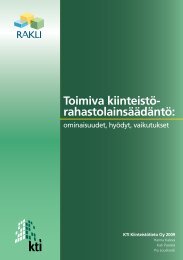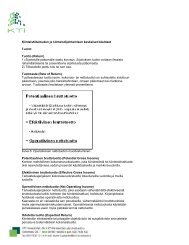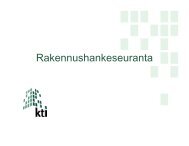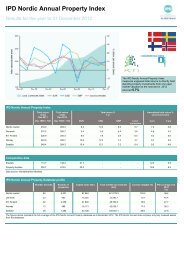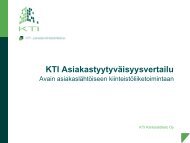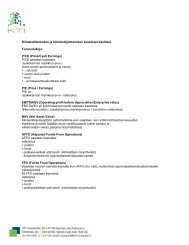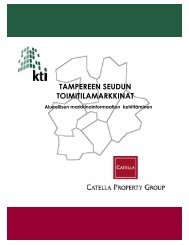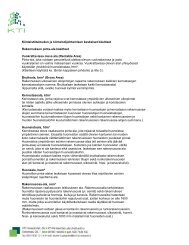Property valuation in the Nordic countries - KTI
Property valuation in the Nordic countries - KTI
Property valuation in the Nordic countries - KTI
Create successful ePaper yourself
Turn your PDF publications into a flip-book with our unique Google optimized e-Paper software.
Executive summary<br />
The “<strong>Property</strong> <strong>valuation</strong> <strong>in</strong> <strong>the</strong> <strong>Nordic</strong> <strong>countries</strong>” study was carried out by IPD and <strong>KTI</strong>, <strong>in</strong> cooperation<br />
with RICS, and it was sponsored by PwC, DTZ and CBRE. The study was carried out by<br />
analys<strong>in</strong>g IPD and <strong>KTI</strong> databases, <strong>in</strong>terview<strong>in</strong>g some thirty <strong>Nordic</strong> property professionals, as well as<br />
organis<strong>in</strong>g workshops for property valuers.<br />
<strong>Property</strong> <strong>valuation</strong> as a profession has gone through a rapid phase of development dur<strong>in</strong>g <strong>the</strong> past<br />
decade <strong>in</strong> all <strong>Nordic</strong> <strong>countries</strong>. This development has been driven by e.g. <strong>in</strong>creased professionalism<br />
of <strong>the</strong> property <strong>in</strong>vestors, <strong>in</strong>ternationalisation of <strong>the</strong> markets, as well as demands for <strong>in</strong>creased<br />
transparency by different stakeholders; e.g. lenders, auditors and regulators. These have led to <strong>the</strong><br />
usage of more sophisticated methods of property <strong>valuation</strong>, <strong>in</strong>creased use of external valuers, as<br />
well as to <strong>the</strong> wider adoption of <strong>in</strong>ternational <strong>valuation</strong> standards.<br />
Even though <strong>the</strong> <strong>Nordic</strong> <strong>countries</strong> are often seen as a unified market area, <strong>the</strong>re are significant<br />
differences between <strong>the</strong> <strong>countries</strong> also <strong>in</strong> terms of property <strong>valuation</strong>s. In Sweden, external valuers<br />
are used extensively, and cash-flow models are <strong>the</strong> prevail<strong>in</strong>g method for <strong>valuation</strong>. In <strong>the</strong> o<strong>the</strong>r<br />
end of <strong>the</strong> spectrum, <strong>in</strong> Denmark, direct capitalisation method is commonly used, and large<br />
<strong>in</strong>vestors often value <strong>the</strong>ir properties <strong>in</strong>ternally. In F<strong>in</strong>land and Norway, <strong>the</strong> use of sophisticated<br />
cash-flow models has <strong>in</strong>creased rapidly dur<strong>in</strong>g <strong>the</strong> past decade. As <strong>the</strong> third option, comparable<br />
sales method is often used <strong>in</strong> comb<strong>in</strong>ation with cash flow models as a check<strong>in</strong>g tool for <strong>the</strong><br />
calculation result (price per sqm), and to derive <strong>valuation</strong> yields for <strong>in</strong>come-based <strong>valuation</strong>s.<br />
International Valuation Standard (IVS) is widely adopted as <strong>the</strong> basis for <strong>valuation</strong>s <strong>in</strong> Sweden<br />
and F<strong>in</strong>land. RICS Red Book – which is also compatible with IVS - is more commonly referred to<br />
<strong>in</strong> Denmark. In Norway, <strong>the</strong>re has historically been less pressure for <strong>valuation</strong> standards and <strong>the</strong><br />
<strong>valuation</strong>s are said to be based on f<strong>in</strong>ancial <strong>the</strong>ory, but <strong>the</strong>re is ongo<strong>in</strong>g work to harmonise <strong>the</strong><br />
property <strong>valuation</strong>s, ma<strong>in</strong>ly <strong>the</strong> outputs <strong>in</strong> <strong>the</strong> <strong>valuation</strong> reports.<br />
In <strong>the</strong> current marketplace, property <strong>valuation</strong>s are fac<strong>in</strong>g new challenges caused by <strong>the</strong><br />
development of <strong>the</strong> property <strong>in</strong>vestment markets. The ma<strong>in</strong> challenge identified by valuers<br />
<strong>the</strong>mselves is <strong>the</strong> ability to ma<strong>in</strong>ta<strong>in</strong> <strong>the</strong> quality and credibility of <strong>valuation</strong>s. This challenge is<br />
largely driven by <strong>in</strong>creas<strong>in</strong>g number of valuers and harder price competition, and also by <strong>the</strong><br />
challeng<strong>in</strong>g economic climate. The quality of <strong>valuation</strong>s is also pressured by <strong>the</strong> low transparency<br />
on market evidence, especially on transactions. Increased liability requirements by <strong>in</strong>ternational<br />
<strong>in</strong>vestors <strong>in</strong> particular require costly <strong>in</strong>surances and <strong>in</strong>crease <strong>the</strong> risk for litigation, which fur<strong>the</strong>r<br />
<strong>in</strong>creases cost pressures towards <strong>valuation</strong>s.<br />
O<strong>the</strong>r trends and challenges identified by different stakeholders <strong>in</strong>clude e.g. <strong>in</strong>dependence of<br />
<strong>the</strong> valuers, comparability of <strong>valuation</strong>s made by different firms, as well as <strong>in</strong>creased need for<br />
transparency of <strong>valuation</strong> parameters and assessments. Ano<strong>the</strong>r factor, which is <strong>in</strong>creas<strong>in</strong>g <strong>in</strong><br />
importance, is energy efficiency and its impact on property values, even though <strong>the</strong>re is not much<br />
empiric data on this available currently.<br />
<strong>Property</strong> <strong>valuation</strong> <strong>in</strong> <strong>the</strong> <strong>Nordic</strong> <strong>countries</strong> 3


